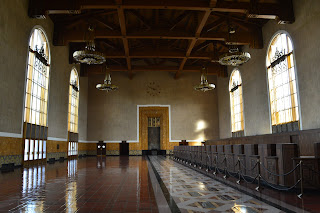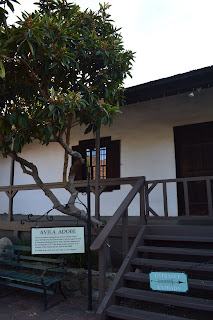Los Angeles hides many towns within the city limits. So labeled by virtue of their history and density of businesses owned by an ethnic minority and the crowds that frequent them.
This trip in L.A was to explore the charm of these pockets of diversity in a crowded metropolis. We began the trip by first visiting the old transportation hub - L.A Union Station. Where trains from different regions along with multiple bus routes converge to take a traveler to and from the city.
Now American transit systems and the infrastructure such as the Union Station certainly lack the efficacy and operational cleanliness of transport hubs in Europe. It is evidenced by the relative apathy the traveling public shows to the system in part because the system does not operate frequently to be viable and neither does it connect from any point A to B given the vastness of this country.
Hardly any traffic on the busiest weekend in America (Thanksgiving) save for a few old couples heading to meet their kids with nothing but time to spare. There is homelessness right around the periphery of the great building along with a prison staring down at you.
But for architectural beauty the premises are worth a visit. A mix of modern and Spanish revival style is used by the architectural firm of Don and John Parkinson and the last of the big rail stations in the USA was completed in 1939.
Heading out of the station complex you can walk right into the old Pueblo of L.A. The Mexican settlement that was originally based here with history dating back to the late 18th century has a market that sells Mexican dolls, leather goods and candy. The oldest home in the city - former residence of Mayor Avila is located here. Lot of the buildings here are Adobe style with red roof consistent to the newer Union Station building that was designed to blend into the landscape.
From here it was two blocks up the hill to meet Bruce Lee and eat some Chinese Shumai.
Chinatown was established by the workers imported from southern China to build the great railroads in America who then settled with their families in this area.
All this development came about due in part of the efforts of a socialite and romantic named Christine Sterling who with her own time and money and persistence urged city leaders to save these neighborhoods and in many cases rebuild and restore a lot of the older structures. The Chinatown is a nod to the Cantonese region with statues of heroes from island nations of Hong Kong (Bruce Lee) and Taiwan (their first president has a statue here).
From here we drove on east to Korea Town to feast on meat cooked on open fire
and then looped back to Japan Town within L.A city limits. The local store sells good fish and (Sushi) rice dishes wrapped in nori.
Our day ended at the beach in Orange County - named for the erstwhile Citrus Orchards now replaced by theme parks et al. However we found a different type of orange to mark the end of another wonderful day.
This trip in L.A was to explore the charm of these pockets of diversity in a crowded metropolis. We began the trip by first visiting the old transportation hub - L.A Union Station. Where trains from different regions along with multiple bus routes converge to take a traveler to and from the city.
Now American transit systems and the infrastructure such as the Union Station certainly lack the efficacy and operational cleanliness of transport hubs in Europe. It is evidenced by the relative apathy the traveling public shows to the system in part because the system does not operate frequently to be viable and neither does it connect from any point A to B given the vastness of this country.
Hardly any traffic on the busiest weekend in America (Thanksgiving) save for a few old couples heading to meet their kids with nothing but time to spare. There is homelessness right around the periphery of the great building along with a prison staring down at you.
But for architectural beauty the premises are worth a visit. A mix of modern and Spanish revival style is used by the architectural firm of Don and John Parkinson and the last of the big rail stations in the USA was completed in 1939.
 |
| Old Reservations Hall - now a wedding ball room available to rent |
 |
| Not much is moving through here - scantily clad departure board |
Heading out of the station complex you can walk right into the old Pueblo of L.A. The Mexican settlement that was originally based here with history dating back to the late 18th century has a market that sells Mexican dolls, leather goods and candy. The oldest home in the city - former residence of Mayor Avila is located here. Lot of the buildings here are Adobe style with red roof consistent to the newer Union Station building that was designed to blend into the landscape.
From here it was two blocks up the hill to meet Bruce Lee and eat some Chinese Shumai.
All this development came about due in part of the efforts of a socialite and romantic named Christine Sterling who with her own time and money and persistence urged city leaders to save these neighborhoods and in many cases rebuild and restore a lot of the older structures. The Chinatown is a nod to the Cantonese region with statues of heroes from island nations of Hong Kong (Bruce Lee) and Taiwan (their first president has a statue here).
From here we drove on east to Korea Town to feast on meat cooked on open fire
Our day ended at the beach in Orange County - named for the erstwhile Citrus Orchards now replaced by theme parks et al. However we found a different type of orange to mark the end of another wonderful day.
 |
| Sunset Beach |











Comments
Post a Comment